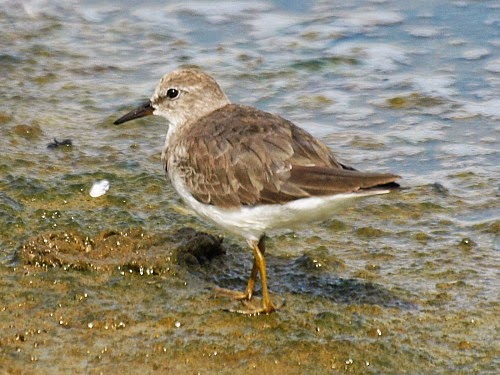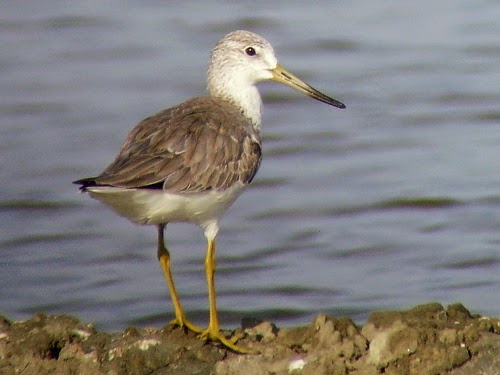An early morning return to the King's Project where another quality species of wader was seen being a pair of Painted Snipe at a small sewage tank although a non-breeding male Watercock seen briefly walking in the open at the edge of some mangroves was more unexpected. A short foray along a road heading inland cutting across some rice paddies inland of the salt pans provided us with a few open country species including some nice views of Blue-tailed Bee-eaters and an obliging smart Long-tailed Shrike. We then continued north stopping at various salt pans all the way to Pak Thale. Highlights included 3 Asiatic Dowitchers, 20 Nordmann's Greenshank, 2,000 Great Knot and a wintering Dusky Warbler just north of the King's Project and 2 Spoon-billed Sandpipers and 2 Far Eastern Curlew at Pak Thale. In contrast to having previously not seen any birders we chatted with Dave Gandy at Pak Thale who told us that birding the day before had been very quiet at Kaeng Krachen National Park and we bumped into a tour group of Yorkshire birders being lead by Games and Ian Dugdale who told us that their visit to Mae Wong National Park had proved excellent despite again narrowly missing Rufous-necked Hornbill. The hoped-for roost of Painted Storks just south of Pak Thale didn't materialise so we headed back to our accommodation in the dark where a Belgian birder had now arrived from Malaysia on a bicycle!
Lesser Whistling Duck c.400
Little Grebe 10
Painted Stork 20
Asian Openbill 60
Night Heron 1
Pond Heron sp. 50
Cattle Egret 12
Grey Heron 6
Great Egret 50
Intermediate Egret 1
Little Egret 10
Little Cormorant 25
Indian Cormorant 2
Osprey 1
Brahminy Kite 3
White-breasted Waterhen 1
Watercock 1
Moorhen 1
Avocet 3
Black-winged Stilt 200
Red-wattled Lapwing 10
Pacific Golden Plover 10
Grey Plover 20
Little Ringed Plover 10
Kentish Plover 25
Lesser Sand Plover 200
Painted Snipe 2
Pin-tailed Snipe 2
Common Snipe 2
Asian Dowitcher 3
Black-tailed Godwit 100
Whimbrel 1
Curlew 300
Far Eastern Curlew 2
Spotted Redshank 2
Redshank 2
Marsh Sandpiper 200
Greenshank 20
Nordmann's Greenshank 20
Wood Sandpiper 6
Common Sandpiper 5
Great Knot 2,000
Red Knot 1
Sanderling 10
Red-necked Stint 50
Temminck's Stint 2
Long-toed Stint 3
Curlew Sandpiper 50
Dunlin 2
Spoon-billed Sandpiper 2
Broad-billed Sandpiper 5
Ruff 1
Brown-headed Gull 200
Gull-billed Tern 10
Caspian Tern 50
Little Tern 100
Whiskered Tern 50
White-winged Black Tern 50
Red Turtle Dove 10
Spotted Dove 10
Peaceful Dove 10
Greater Coucal 5
Asian Koel h
Germain's Swiftlet 25
Indian Roller 3
Smyrna Kingfisher 2
Black-capped Kingfisher 3
Collared Kingfisher 2
Common Kingfisher 2
Green Bee-eater 2
Blue-tailed Bee-eater 4
Peregrine 1
Golden-bellied Gerygone 1
Brown Shrike 1
Luzon Brown Shrike 1
Long-tailed Shrike 1
Black Drongo 50
Malaysian Pied Fantail 6
Large-billed Crow 2
Swallow 20
Dusky Warbler 1
Yellow-browed Warbler 1 + 2h
Oriental Reed Warbler 1
Plain Prinia 2
White-vented Myna 50
Common Myna 2
Asian Pied Starling 6
Magpie Robin 2
Siberian Stonechat 1
Olive-backed Sunbird 2
Tree Sparrow 6
Eastern Yellow Wagtail 2
Richard's Pipit 40
Golden-bellied Gerygone at the King's Project
Red-wattled Lapwing at the King's Project
First-winter Pin-tailed Snipe at the King's Project
Whilst walking the sewage beds a couple of Common Snipe are flushed and tower up into the sky calling, but then also, so too are a couple of low-flying silent Snipe that quickly drop back into land. Too quick for me to obtain critical views, let alone an image, but they have the feel of Pin-tailed Snipe and three images of one of the birds are obtained! A quick review of the images on the back of the camera in the field and a white trailing edge appears evident, bugger, they had looked more interesting than that! Looking at the images on the screen and it looks interesting again... its only showing a thin diffuse pale greyish-white trailing edge to the secondaries and not the broad white trailing edge typical of a Common Snipe, its sandy median and lesser upperwing-coverts form a pale oval panel on its upperwings contrasting with the blacker greater-coverts than shown by a Common Snipe, its primary-coverts are narrowly tipped whitish more so than shown by Common Snipe, its toes project well beyond tail-tip (top image). It can be aged as a first-winter by virtue of it clearly being in the process of moulting some greater coverts that first-winter Pin-tailed Snipe are known to do in winter. Compare the visible feather tracts with an in-hand Pin-tailed Snipe photographed in Thailand in October 2012 by Woraphot Bunkhwamdi below:
Pin-tailed Snipe, Chiang Rai, Thailand, October 2012 Woraphit Bunkhwamdi
Common Snipe, South Korea, April 2008 Tim Edelsten
Common Snipe at the King's Project
In comparison to the Pin-tailed Snipe this Common snipe appears reassuringly very long-billed and its eye-stripe bulges across its lores. Perhaps of most interest it has a black flag on its right tibia and a green flag or ring on its right tarsus. Does anyone know where it was ringed?
Male Painted Snipe at the King's Project
White-throated Kingfisher at the King's Project
Indian Cormorant at the King's Project
Considered a local and uncommon resident in Thailand.
Intermediate Egret at the King's Project
As well as being smaller, shorter-necked and shorter-billed than Great Egret the facial skin doesn't extend in a point behind its eye.
Eastern Yellow Wagtail at the King's Project
The rasping slightly tremulous call was heard well from all Yellow Wagtails heard to call. Clearly this individual is beginning to acquire a green crown and a yellow throat so is presumably of the form Green-crowned Yellow Wagtail M.t. taivana that winters from Myanmar to Taiwan south to Wallacea.
Indian Roller at Lam Pak Bia
Adult Long-tailed Shrike of the form L.s. longicaudatus at Lam Pak Bia
Blue-tailed Bee-eaters at Lam Pak Bia
Asian Openbill at Lam Pak Bia
Black-winged Stilt at Lam Pak Bia
Non-breeding Pacific Golden Plover at Lam Pak Bia
Non-breeding Marsh Sandpipers at Lam Pak Bia
Non-breeding Curlew and Marsh Sandpipers at Lam Pak Bia
Non-breeding Little Ringed Plover at Lam Pak Bia
Long-toed and Red-necked Stint at Lam Pak Bia
Non-breeding Long-toed Stints at Lam Pak Bia
Non-breeding Temminck's Stint at Lam Pak Bia
Peregrine hunting Great Knot at Lam Pak Bia
Non-breeding Great Knot at Lam Pak Bia
This species is classified as Vulnerable owing to a rapid population decline caused by the reclamation of non-breeding stopover grounds, and under the assumption that further proposed reclamation projects will cause additional declines in the future.
Non-breeding Red and Great Knots at Lam Pak Bia
Red Knot is considered an uncommon winter visitor and passage migrant although even Great Knot is considered uncommon mainly passage migrant although there seemed no shortage of them!
Non-breeding Nordmann's Greenshanks at Lam Pak Bia
This species always reminds me of a huge Terek rather than a dwarf Greenshank! Considered an annual but rare winter visitor in Thailand. This species is listed as Endangered because it has a very small population which is declining as a result of the development of coastal wetlands throughout its range, principally for industry, infrastructure projects and aquaculture. Preliminary analyses of survey data collected at its breeding sites in Russia have provided evidence that the species population is indeed undergoing a very rapid decline and imply that the population size may have been overestimated; clarification of these results may lead to a review of its threat status in the near future.
Far Eastern Curlew at Pak Thale
Picked out by virtue of appearing very slightly darker and browner with noticeably buff underparts, lacking a pale supercilium and being very slightly larger and longer-billed than the accompanying orientalis Eurasian Curlews it helpfully revealed its brown lower back, rump and tail when preening. More straightforward when in flight when two birds were seen. Considered a rare passage migrant in Thailand. Unfortunately it is another species considered Vulnerable as it is undergoing a rapid population decline which is suspected to have been primarily driven by habitat loss and deterioration. Further proposed reclamation projects are predicted to cause additional declines in the future.
Spoon-billed Sandpiper at Pak Thale




































































